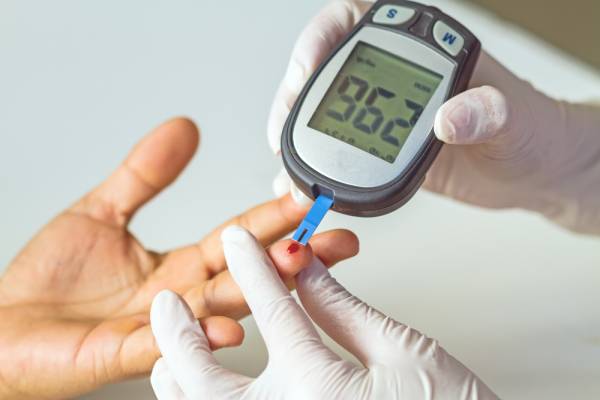Exercise is good, but for type 1 diabetics, it can be very, very bad. Spontaneous exercise in particular can drive blood sugar to dangerously low levels. However, wearable electronic devices are putting increasingly detailed metabolic information within easy reach of the general public.
The study discussed here considers how that technology can help give type 1 diabetics the freedom that non-diabetics take for granted.
Exercise poses unique risks for people with type 1 diabetes.
Blood Sugar Complications
In type 1 diabetes, the patient’s pancreas produces little or no insulin. Without a natural supply of the hormone responsible for mediating blood sugar concentrations, a type 1 diabetic depends on regular insulin injections instead.
“Diabetes management involves carefully balancing insulin injections and carbohydrate consumption to maintain a blood sugar level in between these two extremes.”
Excessive blood sugar increases the risk of diabetic complications, including retinal and peripheral nerve damage, which can lead to blindness and the loss of digits, respectively. Low blood sugar is equally dangerous, potentially causing dizziness, confusion, and unconsciousness. Diabetes management involves carefully balancing insulin injections and carbohydrate consumption to maintain a blood sugar level in between these two extremes.
Exercise and Glucose
Exercise can play an important role in maintaining this balance. It burns glucose and improves insulin sensitivity. Moreover, diabetics derive the same exercise-related improvements in mental wellbeing and cardiovascular health that non-diabetics do.
Unfortunately, exercise also poses unique risks for diabetics. The glucose burned during exercise may not be replenished quickly enough, leading to hypoglycemia and its associated risks. The longer the exercise duration, the greater the risk.
“[A]ny adjustment to a diabetic’s insulin regime requires advance planning. For this reason, fear of hypoglycemia is a significant barrier to exercise among type 1 diabetics.”
While, in theory, it is possible to increase carbohydrate consumption or reduce insulin levels to compensate, doing so runs into practical challenges. There is no scientific consensus on exactly what adjustments are recommended, with estimates ranging from an additional thirty grams of carbohydrate per hour to almost double that amount.
Moreover, any adjustment to a diabetic’s insulin regime requires advance planning. For this reason, fear of hypoglycemia is a significant barrier to exercise among type 1 diabetics. It can be especially problematic when considering spontaneous activities: a hike in the woods or a bike ride with family members, for example.

Any adjustment to a diabetic’s insulin regime requires advance planning.
The ECRES Solution
The ECRES algorithm (Exercise Carbohydrates Requirement Estimating Software) seeks to remedy this problem. Given the patient’s normal diet, insulin regimen, and activity level, it estimates the insulin profile and required carbohydrate intake over the course of a day. When exercise is contemplated, the algorithm can estimate carbohydrate requirements based on the expected exercise intensity and duration, given the patient’s measured blood sugar level at the time. Thus, it allows patients to determine how to adjust their carbohydrate intake to accommodate spontaneous activity.
“The ECRES algorithm seeks to remedy this problem. Given the patient’s normal diet, insulin regimen, and activity level, it estimates the insulin profile and required carbohydrate intake over the course of a day.”
Because it depends only on information readily available to the patient – blood sugar level, insulin and carbohydrate intake, and estimated heart rate – ECRES is suitable for implementation by smartphones, fitness monitors, and other portable electronic devices and can be readily incorporated into the patient’s daily life.
What the Research Says
Previous research has validated the ECRES algorithm for short-duration exercise of an hour or less. In the study discussed here, researchers at the University of Udine, Italy applied it to long-duration, low- to moderate-intensity exercise.1
Nine participants – five male and four female – walked on a treadmill for three hours at a “brisk” pace, estimated at 50-60% of maximum heart rate. Heart rate was monitored continuously and blood sugar at thirty-minute intervals. The participants, all of them type 1 diabetics with well-established metabolic control regimes, were given either candy or direct glucose injections as needed to maintain blood sugar at a safe level. Participants followed their normal diet and insulin regimens before the test, simulating spontaneous activity under “free living” conditions.
After the test, actual glucose consumption was compared to the glucose requirement predicted by the ECRES algorithm. The two were found to be in close agreement. Moreover, the ECRES estimate was closer to the actual requirement than other methods found in the literature. The thirty grams of carbohydrate per hour estimate would have led to excessive blood sugar levels, so higher intakes would have been even worse.

The ECRES algorithm can help predict carbohydrate intake that will maintain blood sugar in a healthy range.
Conclusion
While the researchers conceded that the small sample size and precise exercise protocol limited the applicability of their work, they concluded that the ECRES algorithm can remove a major barrier to exercise among type 1 diabetics. Rather than evaluating the metabolic consequences of exercise for themselves, they can depend on the algorithm to suggest carbohydrate intake that will maintain their blood sugar in a healthy range.
Further Reading:
- Working With Special Populations, Part 3: Diabetes Mellitus
- Weight Training Can Help Diabetics Manage Blood Sugar
- Prevent Type 2 Diabetics With Resistance Exercise
- New on Breaking Muscle Today
References:
1. Maria Pia Francescato, et. al. (2015) “Prolonged Exercise in Type 1 Diabetes: Performance of a Customizable Algorithm to Estimate the Carbohydrate Supplements to Minimize Glycemic Imbalances.” PLoS ONE 10(4): e0125220. doi:10.1371/journal.pone.0125220
Photos courtesy of Shutterstock.






